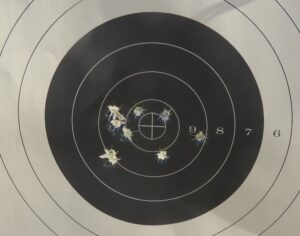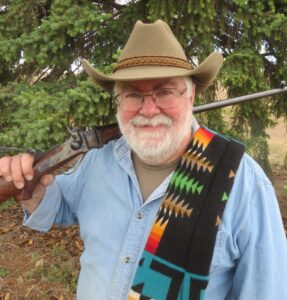
By Mike Nesbitt|Contributing Editor
Images by author
To lube or not to lube, that is the question… Shooting long range black powder cartridges without having lubrication either on the bullets or under the bullets in the loads is nothing new.
Most if not all of the shooters at the old Creedmoor matches in the 1870s did not have lube in their loads. Not having lubrication in those paper patched bullet loads simply necessitates cleaning or wiping and drying the bore after every shot. Obviously, the lubricant on or under the bullets in black powder loads is really for the following shot and not for the bullet that’s going down the barrel. The lube keeps the fouling soft for that next shot.

The paper patch on a lead bullet is simply a paper jacket and its only mission is to prevent or reduce leading by keeping the lead of the bullet separated from the bore. Once the bullet leaves the muzzle, the job of the paper patch is done and the paper falls to the ground.
If we were making hunting loads with those paper patched bullets, we would certainly want to use lubrication so follow-up shots could be taken without the need to wipe out the barrel. In order to explain how this is done, let me briefly describe loading a paper patched round.
First of all, we’ll say that the re-sizing, expanding, and re-priming is already done. So we’ll step into this loading process with the pouring of the powder. Further into this story I’ll be mentioning powder charges and here I’ll just say that the powder is poured into the case. Then on top of that powder goes an “over-powder wad” and in most loads the powder is then compressed to make room for the other components.
If lube is to be used, it is added on top of the over-powder wad. This is done with what we call a “grease cookie,” usually a beef tallow and beeswax mixture or a small disc of a black powder bullet lubricant, about 1/8-inch thick. That is followed with another wad, which keeps the grease away from the base of the bullet. Finally, the paper patch bullet is added to the load, usually simply “seated” with fingertips because the paper patches could be torn if the bullets were seated with the loading press.

That is a rather summarized description of loading paper patched bullets and it is also generalized. Each shooter might and probably does have tiny quirks about such loads and we can get into greater details only after some experience with a particular rifle and caliber. What I really wanted to describe was how the lube is added beneath the bullet in a paper patch round.
If the lube is not used, that gives more room for powder and in black powder long range shooting, using more powder has advantages. More powder can quickly translate to higher velocities which can help our bullets reach their targets. While shooting those paper patched loads without lubrication, the wiping of the bore between shots is needed.
Everything said in this story so far has been quite generalized. You might note that I haven’t even mentioned a specific rifle or cartridge yet. From here the plot thickens and we’ll put some of those general comments to use along with reasons for not using a lube.
Just a couple of months ago our club, the Black River Buffalo Runners, held a paper patched bullet match, featuring shots at 100 and 200 yards. The rifle I used in this match was my Model 1874 Bridgeport by C. Sharps Arms with the 34-inch barrel. I’ve had that rifle about two years but never used it in competition before, and now I’ll probably be using it again! The loads I tried had 525 grain bullets cast from Hoch mold, wrapped in nine-pound paper from Buffalo Arms Company.
Those bullets were seated rather deeply in Starline .45/70 cases over 70.0 grains of Olde Eynsford 1 1/2F black powder, compressed under a .030” fiber wad with no lube beneath the bullets.
My shooting with that combination pleased me quite well. The scores on my targets could have been higher but I’ll probably always say that… As it was, I got an 86 out of 100 at 100 yards and a 94-XX at 200 yards. Those scores put me in second place. The shooting and wiping while maintaining a sitting position does take some coordination, that’s where I need more practice.
The winner of that match was Allen Cunniff, my Quigley partner. Allen was using his Remington rolling block, rebuilt to .45/70 using a 30-inch Shilen barrel. Allen stocked this rifle with wood from Treebone and C. Sharps Arms did the bluing and the very attractive color casehardening.

His cartridges were loaded with 525 grain bullets cast from a mold by the late Tom Ballard then wrapped with nine-pound onionskin paper, over 68 grains of Olde Eynsford 1 1/2F powder. No lube was included in his load so he also wiped his barrel between shots. With that combination Allen shot the high scores at both 100 and 200 yards, finishing with a score of 192-4X, only 8 points below the 200 points possible.
Allen’s good shooting prompted him to use his Model 1874 custom rifle from C. Sharps Arms with paper patch loads for the coming Matthew Quigley Buffalo Rifle Match near Forsyth, Montana which we’ll be going to very soon. One reason why he wanted to use the Sharps was for the double-set triggers. But before doing so, he wanted to do some checking with his loads and the Sharps rifle at longer ranges. That interested me too so off we went to a good spot where we could shoot 1000 yards if we wanted to.
While getting his sight settings with the paper patched load at 600 yards, Allen found he was having trouble with consistency. His shots were scattering with no quickly apparent reason why. In addition to that, with our spotting scope we had a lot of trouble seeing the hits on the target at that distance. In order to help this situation, Ash Garman, our host at his range, went down range to sit in a protected spot so he could spot the bullet holes in the target for us. That was when the real key to Allen’s shooting began.

We were in contact with walkie-talkies while Ash was down range and he’d call us with an “all clear” when he was safely tucked away beneath a hill. I’d reply with a “comin’ to ya!” before Allen fired. Then Allen fired a carefully aimed shot and we expected Ash to give us a positive report. I was watching for the shot through a spotting scope at the same time. In just a split second or two after the shot Ash comes back on the walkie-talkie with “What the hell was that!?!” We had no idea what he meant until he listened to another bullet going by and then explained. Those bullets sounded like a buzz-bomb going by, like they were ripping the air with an interrupted tear most likely caused by some accuracy ruining wobble of the bullets.
The sound a bullet makes as it passes by is actually the air closing on the void left by the flying bullet. It should be a smooth sound. If there is something irregular about the sound it is a real indication about something irregular in the flight of the bullet. Then Allen re-considered his wiping of the barrel. When he’d wipe, there would be a short section of the bore near the muzzle that seemed to retain some hard to dislodge fouling. Perhaps he needed to add some lube to his paper patched bullet loads after all.

To do so, some bullets were pulled from his already prepared ammo. A “grease cookie” was put into each of the ten rounds to be tried and then the bullets were re-seated. With that done we went back to our “shooting sticks.” Ash went back down range and after his “all clear” a shot was fired. “That sounded great!!” was Ash’s immediate comment. And the shot was a good one. With a couple of adjustments, Allen could keep his shots in the higher scoring rings at 600 yards. Those paper patched bullets to be used at Quigley will have lube beneath them.
Even with that lube beneath the paper patched bullets, Allen will still be wiping the rifle’s bore between shots. Just a little bit of fouling in the bore, near the muzzle, was all it took to give those bullets a wobble. That irregularity was not noticed at 200 yards but out at 600 yards it gave some real trouble. And we would have never known that if it wasn’t for having some “ears” down range to hear the bullets fly over. We’ll lube our loads from now on…



